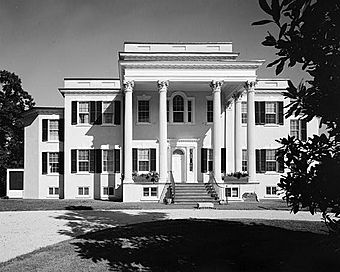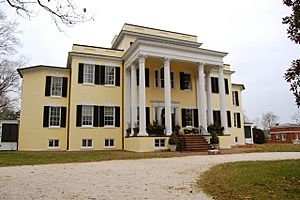- This page was last modified on 17 October 2025, at 10:18. Suggest an edit.
Oatlands Historic House & Gardens facts for kids
|
Oatlands Historic District
|
|

Main House of Oatlands Historic District (1973)
|
|
| Location | Loudoun County, Virginia |
|---|---|
| Nearest city | Leesburg, Virginia |
| Area | 415 acres (168 ha) (landmarked area) |
| Built | ca. 1804 |
| Architect | George Carter (original) |
| Architectural style | Federal, Greek Revival |
| NRHP reference No. | 69000255 (original) 74002327 (expansion to district) |
| Significant dates | |
| Added to NRHP | November 12, 1969 (original) May 3, 1974 (expansion to district) |
| Designated NHL | November 11, 1971 |
Oatlands Historic House and Gardens is a beautiful old estate in Leesburg, Virginia. It used to be called Oatlands Plantation. Today, the National Trust for Historic Preservation takes care of Oatlands. It is recognized as a National Historic Landmark because of its importance.
The Oatlands property includes a large main house, called a mansion, and about 415 acres of farmland and gardens. The mansion is considered one of the best examples of a country estate built in the Federal style. Besides the mansion, there are other buildings on the property. These include a Carriage House, a Bachelor's Cottage, several barns, and farm buildings. There is also a greenhouse built in 1810, which is thought to be the oldest standing greenhouse in the Southern United States.
Contents
History of Oatlands
Early Beginnings
Oatlands was started in 1798 by George Carter I. He was a great-grandson of a very important person named Robert "King" Carter. George Carter began Oatlands on a large piece of land, about 3,408 acres.
At first, it was a farm mainly for growing wheat. Over time, it grew to include other grains, sheep, and even a vineyard. There was also a gristmill for grinding grain and a saw mill for cutting wood.
Building the Mansion and Gardens
In 1804, George Carter started building the main house, the mansion. He continued to make it bigger and better in the 1820s and 1830s. During this time, beautiful terraced gardens were added. Many other smaller buildings were also built around the estate.
Life and Labor at Oatlands
The farm and businesses at Oatlands relied on the work of enslaved people. When George Carter first took over the land, 17 enslaved people lived and worked there. Over the years, more enslaved people were bought. Also, children born to enslaved parents were also considered enslaved. By 1860, about 133 people were enslaved at Oatlands.
Their work was very important for the estate. They planted and harvested crops in the fields. They also cared for the farm animals. Inside the mansion, they did domestic work like cooking, cleaning, caring for children, and sewing. It is also likely they worked in trades such as blacksmithing and milling.
Changes in Ownership
After George Carter passed away in 1846, his wife, Elizabeth Grayson Lewis Carter, inherited Oatlands. In 1861, during the American Civil War, Elizabeth Carter worried about battles happening nearby. She moved to another one of her properties.
Her oldest son, George Carter II, and his wife, Katherine Powell Carter, reopened the mansion in 1863. George Carter II inherited the property when his mother passed away in 1887.
In 1897, the Carter family sold the mansion and 60 acres of land. It was bought by Stilson Hutchins, who founded The Washington Post newspaper. However, he never actually lived at Oatlands.
The Eustis Family Era
In 1903, Stilson Hutchins sold Oatlands to William Corcoran Eustis and Edith Livingston Morton Eustis. Mrs. Eustis loved gardens and worked hard to bring the neglected gardens back to life. She added beautiful boxwood hedges, statues, a rose garden, a bowling green, and a reflecting pool. Today, you can still see some of the old trees and plants she put in.
The Eustis family also updated the house with modern comforts. They added indoor plumbing, heating, and gas lighting. They put new pine floors over the original ones. An elevator was installed, and a special bathroom was built on the first floor for their childhood friend, Franklin D. Roosevelt.
The Eustises were well-known in Washington, D.C.. They had many famous friends, including General George C. Marshall, Henry Cabot Lodge, President Harry S. Truman, and Franklin and Eleanor Roosevelt.
Oatlands Becomes a Historic Site
After Mrs. Eustis passed away in 1964, her daughters, Margaret and Anne, decided to donate the mansion, its furniture, and the estate grounds. They gave it to Margaret's husband, David E. Finley, Jr.. He was the founder of the National Trust for Historic Preservation.
Oatlands was officially named a National Historic Landmark in 1971. In 1974, the area around the landmark was also recognized as the Oatlands Historic District. This district includes other important places like Oatland Mills, the Mountain Gap School, and the Church of Our Savior.




